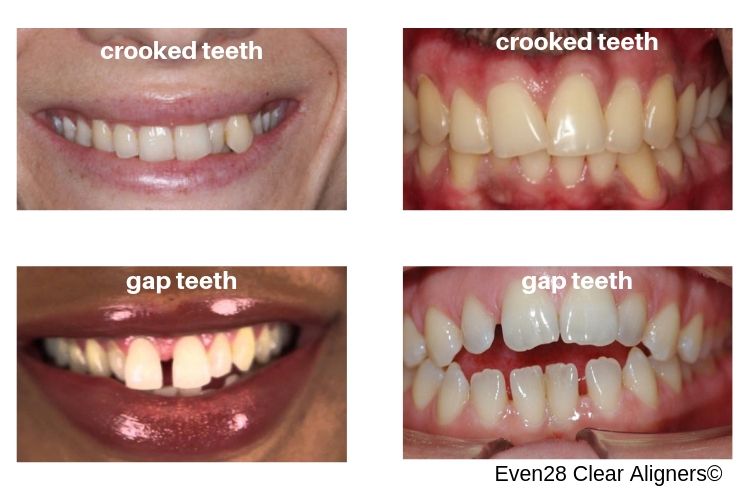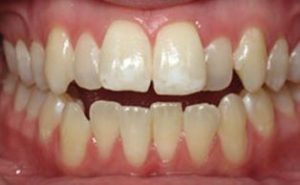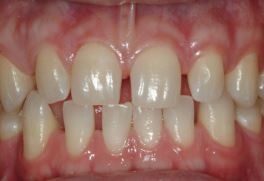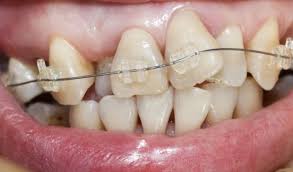Even28 at-home™ clear aligners
Clear aligners offer an innovative way to straighten your smile. In contrast to braces, clear aligners are gentle, removable, and barely visible in your mouth. At-home aligners are much more affordable than traditional clear aligner systems, which require constant dentist supervision. You can use at-home clear aligners to fix many different types of minor orthodontic misalignments. These include:
- Closing small gaps between your teeth
- Fixing slightly crooked front teeth
- Straightening that one snag tooth that refuses to line up with other teeth!
There are several different at-home clear aligner systems to choose from. These include Smile Direct Club™, Byte™, Candid Co.™, and Even28 at-home™ to name a few.
Benefits of at-home clear aligner therapy
 Ideal candidates for Even28 at-home clear aligner treatment are those with crooked or gap front teeth.
Ideal candidates for Even28 at-home clear aligner treatment are those with crooked or gap front teeth.
There are several companies that offer at-home clear aligner therapy. Here is a list of some of the most popular at-home clear aligner manufacturers:
- Smile Direct Club™
- Byte™
- Candid Co.™
At-home clear aligners are a simple and convenient alternative to dentist-supervised clear aligner programs, such as Invisalign® and ClearCorrect™. Here are a few reasons why you should choose at-home clear aligners over traditional ones:
Results in months not years
In most cases, at-home aligners straighten your smile in as little as 3 to 6 months. The average treatment time for at-home clear aligners is just over 5 months. This means your straight smile could be less than half a year away!
Affordable
Smile Direct Club™ and Candid Co.™ aligners typically cost between $2,000 to $2,500 for your entire teeth straightening treatment. That’s nearly 50% less than what most Invisalign® providers charge. In other words, you can straighten your smile using Smile Direct Club™ aligners, get your deep cleaning, and fix a few cavities, for the same price as Invisalign® clear aligners by themselves!
Convenient
Smile Direct Club™ and Candid Co.™ give you all of your clear aligners upfront. This means that there are no additional visits throughout your treatment. In contrast, you are required to see your Invisalign® provider on a biweekly or monthly basis until the completion of your treatment.
Flexible financing options
At-home clear aligner programs let you straighten your smile without breaking the bank. For example, Smile Direct Club™ clear aligners cost as little as $89 a month for those who qualify (and almost everyone qualifies!) Dentists who offer Invisalign® and ClearCorrect™ may or may not offer monthly financing options. Plus, you need to have good credit to get qualified. Lastly, should you qualify for financing, you’re still looking at a few hundred per month in contrast to $89 for Smile Direct Club™.
Which cases qualify for at-home clear aligner treatment?
At-home clear aligners are perfect for treating simpler orthodontic conditions. Complex orthodontic conditions can not be treated using at-home clear aligners. The more complicated cases always require dentist-delivered clear aligners, like Invisalign®, or braces. So how can you tell if your case qualifies for at-home clear aligners? The best way is to see your dentist or orthodontic for a clear aligner consult. Here are a few examples of good candidates for at-home clear aligner therapy:
aka crooked front teeth

aka gaps between front teeth

aka snaggletooth!

You forgot to wear your retainers…for like 5 years!

Click here to take our at-home clear aligner assessment quiz to see how likely you are to qualify for at-home clear aligner treatment.
How long does at-home clear aligner therapy take?
At-home clear aligner therapy takes between 3 to 9 months to straighten most smiles. The median treatment time is 5 months. Naturally, treatment times vary based on the complexity of tooth movement. If you’re not satisfied with the end results, you will be given a few additional aligners. These are referred to as refinement aligners. Refinement aligners are typically worn for 2 to 3 additional months. This brings the total treatment time to between 5 to 12 months. Ultimately, 90% of at-home clear aligner cases are finished in under one year.
Tips on how to wear at-home clear aligners
Smile Direct Club™, Candid Co.™, and Byte™ are a few of the more popular at-home clear aligner programs. You can learn more about each clear aligner program by visiting their website. Here are a few general tips on how to wear your clear aligners:
Give yourself time to get used to your new aligners
Clear aligners can feel a bit awkward at first. Don’t worry, almost everyone gets used to them after the first 2 to 3 days. As you continue going through your clear aligners, they become easier and easier to wear. A good piece of advice is to wear your new clear aligner at night. This way, you can go right to sleep and adapt to them overnight. Try drinking cold soda or gas water if it’s painful. As a last resort, take a pain killer like Tylenol or Advil. Give it a day or two and you’ll get used to your new clear aligners before you know it.
Wear each aligner for the recommended time period
Don’t rush going through wearing your clear aligners. If you switch your aligner too quickly, they won’t move your teeth properly. Here are 3 important rules which you must follow when it comes to wearing your clear aligners:
- Wear your clear aligners in the correct sequence, aka aligner #1, #2, #3, etc.
- Wear each clear aligner for the recommended number of hours throughout the day
- Wear each aligner for no less than 2 weeks and no longer than 4 weeks
Don’t rush through your aligner therapy
Clear aligner therapy takes some time. Be sure to follow your doctor’s instructions. Never skip an aligner. Wear each aligner for a minimum of 2 weeks before switching to the next one. Why 2 weeks? If you wear your clear aligner for less than 2 weeks, your teeth won’t stabilize in their new position. This means that your teeth can easily bounce back to their previous position. If you switch to a new aligner and it’s very painful, feel free to continue wearing your previous aligner for an additional 2 to 3 days. The maximum wear time for each aligner is 4 weeks. If you’re still having a hard time switching to your next aligner after 4 weeks, contact your dentist or aligner provider company to find a solution.
Different wear methods for different folks
You must wear your clear aligners between 10 to 22 hours a day. Here are the 3 most common methods you can wear your clear aligners:
- Full-time: The standard wear method requires you to wear your clear aligners full time for 2 weeks. You must wear your aligner for 21 to 22 hours per day. Only take them out when you’re eating, drinking, or brushing your teeth. Water is the only exception, and you can leave your aligners in when sipping water.
- Daytime wear: With this method, you can wear your aligners during the day and take them out at night. With the daytime wear method, you should wear each aligner for 3 weeks instead of the usual 2 weeks.
- Nighttime wear: This method requires you to wear your aligners during the night. You can take them out when you are awake. With the nighttime wear method, you should wear each aligner for 4 weeks.
Click here to learn more about the different clear aligner wear techniques.
Additional tips on caring for your teeth and aligners
- Wear your aligners even when you are asleep (unless you’re using the daytime only wear method)
- If your clear aligners are not seating all the way, bite on your chewies for several minutes to seat them in place
- If your aligners are too tight, stand in front of a mirror and use your outtie tool to remove them
- Clean your aligners using liquid soap, however, avoid toothpaste as it could damage your aligners
- Keep each aligner in its proper packaging and never throw them away, just in case you end up having to re-use them
- Be sure to remove your aligners daily and continue to brush and floss your teeth as you normally would
- Maintain your regular dental cleaning appointments throughout your aligner treatment
What if I don’t qualify for at-home clear aligners?

At-home clear aligners are perfect for more simple tooth movements. However, more complex orthodontic conditions can not be fixed using at-home clear aligners. These include straightening really crooked teeth, correcting underbites, as well as crossbites. Now, this doesn’t automatically mean that you have to wear braces. You may still qualify for dentist-delivered clear aligner programs like ClearCorrect™️ or Invisalign®. Dentist-delivered clear aligner programs allow for more control over tooth movement. These programs are offered through local dentists and orthodontists. Here are a few examples of orthodontic conditions which typically don’t qualify for at-home clear aligners:
Orthodontic cases that require bite correction
You need a dentist, preferably an orthodontist, to correct your bite issues. As a result, any orthodontic case that requires bite correction must be treated under direct dentist supervision. This is regardless of whether you choose clear aligners or braces. There’s a good chance your dentist will use attachments (buttons), perform tooth contouring, enamelplasty, and other techniques to assist in tooth movement. Bite problems stress your teeth and jaw joints. This can lead to tooth fracture, failure of dental restoration, headaches, TMJ problems, and other serious complications. Always go with dentist-delivered clear aligners like Invisalign® or ClearCorrect™, or with braces, if you require bite correction.
Complex tooth movement
Tougher orthodontic conditions should not be treated with at-home clear aligner programs. For instance, extremely crowded teeth don’t respond well to at-home clear aligner therapy. To properly straighten super-crowded teeth, your dentist must create additional space for tooth movement. This technique, known as tooth contouring or interproximal reduction (IPR), can only be performed by a licensed dentist. Without proper dentist supervision, you could end up with subpar results. Plus, your teeth are likely to relapse back to their original position within a few years after treatment. Tougher orthodontic conditions should always be treated using dentist-directed clear aligners. The other option is to wear braces.
Ready to start straightening your smile?
There are so many different ways to straighten your smile nowadays. At-home clear aligners programs like Smile Direct Club™ and Candid Co.™ are perfect for fixing minor tooth movements. Dentist-supervised clear aligner systems like Invisalign® and ClearCorrect™ are ideal for more complex cases that require constant dentist supervision. The most complex orthodontic movements require braces. If you don’t already have a dentist, click here to use our dentist Search Engine to find a provider near you. If you have any additional questions, contact us at admin@even28.com and one of our representatives will reach out to help you straighten your smile!